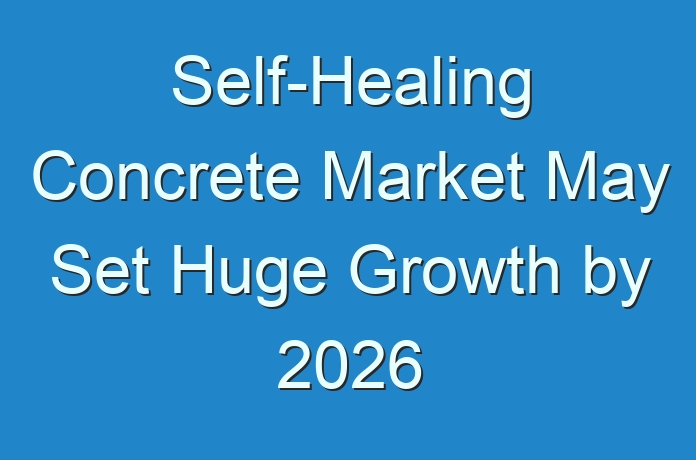
Self-Healing Concrete Market – Overview
Concrete is the single most widely used material in the construction and infrastructure industry. Any structure containing concrete is susceptible to corrosion due to environmental factors such as extreme heat and cold. Such conditions lead to the development of cracks in the structure, which can lead to structural weakness over a period of time if not repaired promptly. These repair and maintenance activities add to the overall maintenance cost. This prompted research and development activity to look for cheaper alternatives. Self-healing concrete is a technology invented to overcome these difficulties. Certain chemicals are mixed with the concrete during the manufacturing process whose properties get activated when the structure starts deteriorating, thus reducing the need for reinforcement. Self-healing concrete is of two main types: bio-based and synthetic-based. Microorganisms such as bacteria and fungi are mixed with the cement during the concrete manufacturing process which release their properties when exposed to atmospheric elements such as air and moisture. Similarly, when synthetic polymers are mixed with the cement, they react with air & moisture and cause the structural damage to repair itself. Self-healing concrete gets its name from this property.
Request A Sample :
https://www.transparencymarketresearch.com/sample/sample.php?flag=S&rep_id=63465
Self-Healing Concrete Market – Drivers and Restraints
Rising investment in the infrastructure sector and need to reduce overall structural maintenance costs are expected to be the key drivers of the global self-healing concrete market during the forecast period. The use of self-healing concrete presents immense benefits in terms of overall reduction of expenditure for repair and maintenance. Researchers have found these benefits to be up to 50%, which is a significant reduction. Cost-reduction through the development of cheaper versions of self-healing concrete would help raise the consumption of the product and enable wider distribution of the benefits associated with it. The benefits for larger structures, especially the underground ones, are significant. Focus toward improving durability of structures is anticipated to drive the global self-healing concrete market.
As with any research and development activity, the gestation period until final implementation of a technology takes a long time. The same goes for the global self-healing concrete market. This is expected to lead to high initial cost of production till the technology is scaled up to meet demand, which is a restraint for the market.
The cement manufacturing industry is responsible for ~5% of the total global CO2 emissions, and concrete is the final product of this industry. Thus, increasing investments in the manufacture of self-healing concrete is projected to not only enable cement manufacturers to reduce their carbon footprint, but also mitigate costs incurred on repeated cement manufacturing for maintenance and reinforcement purposes. This presents a growth opportunity for cement manufacturers. Additionally, self-healing concrete is superior in terms of quality when compared to ordinary concrete due to its higher durability. This is anticipated to lead to greater demand from end-users.
Buy our Premium Research Report@
https://www.transparencymarketresearch.com/checkout.php?rep_id=63465<ype=S
Self-Healing Concrete Market – Segmentation
The global self-healing concrete market can be segmented on the basis of technology, end-use, and region. In terms of technology, the self-healing concrete market is segmented into Micro-organism based and polymer-based. Based on end-use, the market is segmented into public and private sector. On the basis of region, the global self-healing concrete market can be segmented into North America, Europe, Asia Pacific, Middle East & Africa, and South America.
Self-Healing Concrete Market – Key Players
Companies such as Basilisk, Acciona Infraestructureas S.A, Avecom, and Fescon manufacture self-healing concrete for commercial use. Ongoing research activities by academicians and universities in collaboration with industry partners to develop newer technologies in self-healing concrete is being done. These initiatives are undertaken in association with infrastructure industry partners to test the efficacy of the developed material so as to move the product to the next level that is commercial production. Magnel Laboratory for Concrete Research of the Department of Structural Engineering at Ghent University is one such academic project. The outcomes of such research projects being carried out by institutions the world over is likely to prove beneficial for the commercial manufacture of self-healing concrete.
About Us
Transparency Market Research is a next-generation market intelligence provider, offering fact-based solutions to business leaders, consultants, and strategy professionals.
Our reports are single-point solutions for businesses to grow, evolve, and mature. Our real-time data collection methods along with ability to track more than one million high growth niche products are aligned with your aims. The detailed and proprietary statistical models used by our analysts offer insights for making right decision in the shortest span of time. For organizations that require specific but comprehensive information we offer customized solutions through adhoc reports. These requests are delivered with the perfect combination of right sense of fact-oriented problem solving methodologies and leveraging existing data repositories.
TMR believes that unison of solutions for clients-specific problems with right methodology of research is the key to help enterprises reach right decision.
Contact Us
Transparency Market Research
State Tower,
90 State Street,
Suite 700,
Albany NY – 12207
United States
USA – Canada Toll Free: 866-552-3453
Email: sales@transparencymarketresearch.com
Website: https://www.transparencymarketresearch.com





